 Wellington Street: (off George Street) In 1840, there was a pub here with the curious name of The Sign of the Board. Wellington Street: (off George Street) In 1840, there was a pub here with the curious name of The Sign of the Board.
The Waterloo Tavern is listed in Pigot's Directory for 182/9 when the licencee was John Radcliffe. Another Waterloo Tavern was in Boughton.
The Liverpool Arms stood at the junction of Lyon Street, Wellington Street and Brook Place, Newtown. It is shown on a map of 1870 but, for the moment, we know nothing more about it.
Westminster Park (Lache Lane): The Westminster Park (formerly The Lache, illustrated left).
A planning application by David McLean Homes to build
houses on the site of this perfectly useable building was refused in November 1998-
but then, inevitably, allowed upon appeal. The lack of other pubs in the area led
to a great deal of public objection, but nevertheless, it was demolished in
July 1999 and the houses duly built.
White Alley was a narrow lane off George Street and adjoining the Cattle Market. On the corner of these streets was The Drover's Arms. It may be seen in this detail from the 1875 Chester OS map.
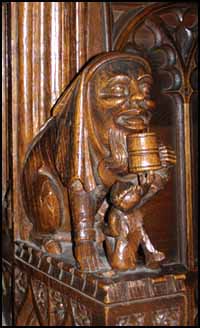 Whitefriars: The King's Head - recorded as being used as a polling station in 1809. Listed in Pigot's Directory for 1818-20 when the licencee was William Roberts, in 1822-3 Samuel William and in 1828/9, William Posnett. Much more about this pub under Grosvenor Street. Whitefriars: The King's Head - recorded as being used as a polling station in 1809. Listed in Pigot's Directory for 1818-20 when the licencee was William Roberts, in 1822-3 Samuel William and in 1828/9, William Posnett. Much more about this pub under Grosvenor Street.
Werburgh Lane (now St. Werburgh Street): The Crown Tavern. The street is listed in Pigot's Directory 1818-20 as Warburgh's Lane and lists this tavern- licencee C Ladmore- as trading there.
Right: dating from c1300, here is one of the strange bench-end carvings in the Choir of Chester Cathedral- half beast, half pilgrim, enjoying a mug of ale...
William Street: The Ship Victory (no. 48, corner of George Street). This popular community pub closed, apparently for good, with the retirement of its longtime licencees Joe and Helen Gildea on New Year's Day 2014. See our new page about it in the gallery here..
"Oh, beer! It makes good cheer,
And proves the poor man's worth;
It cools the body through and through, and regulates the health"
Anonymous
Unknown Locations: the Pig & Tinder Box: to quote the Cheshire Sheaf of January 1884, "in an old letter written from Chester Fair in 1780,
incidental mention is made by the writer, a Yorkshire dealer, to the Pig & Tinder Box (an inn, I assume) where he was then lodging during the Chester July Fair of that year".
The Blackamore's Head was mentioned in the records of a court case in 1640 when depositions were taken here. Its location was not recorded but the tenant at the time was William Wilbraham.
The Bleeding Horse (what a name!) was kept in 1778-1779 by Joseph Moors. We's love to know more.
The Hat & Beaver's landlord in 1778 was Thomas Hill- but where was it?
"I believe, if we take habitual drunkards as a class, their heads and their hearts will bear an advantageous comparison with those of any other class. There seems ever to have been a proneness in the brilliant and warm-blooded to fall into this vice." Abraham Lincoln
 Vanished Chester Breweries: In 1487, the town's constables recorded that there were five brewers outside the Northgate, two in Handbridge and twenty one thriving in the area outside the Eastgate. However, brewing had almost disappeared from Chester by the late 19th century, and by 1909 only one concern was left. The decline was due to the elimination of public-house breweries and the concentration of ownership among the commercial brewery companies. Vanished Chester Breweries: In 1487, the town's constables recorded that there were five brewers outside the Northgate, two in Handbridge and twenty one thriving in the area outside the Eastgate. However, brewing had almost disappeared from Chester by the late 19th century, and by 1909 only one concern was left. The decline was due to the elimination of public-house breweries and the concentration of ownership among the commercial brewery companies.
In 1871 there were 13 breweries in Chester, of which seven appear to have been pub breweries. All the latter had ceased operation by 1892. Of the commercial breweries, the three biggest were Edward Russell Seller & Co. in Foregate Street, the Lion Brewery in Pepper Street, and the Chester Northgate Brewery next to the Northgate. The Seller family owned the first mentioned until 1889 when the concern was sold to the Albion Brewery Co. of Wigan and closed down shortly afterwards.
In 1697, a messuage (dwelling house), cellar, kiln and malthouse in the holding of William Sudlow, apothecary and bearing the curious name of The Hand & Snake (was it also an inn?) was first recorded as standing in Pepper Street. Between 1871 and 1892 the premises passed through at least four hands- including the Whittells and Messrs Walton & Clare- before being acquired by Thomas Montgomery. His business was incorporated as the Chester Lion Brewery Co. Ltd. in 1896, but was taken over by Bent's Brewery of Liverpool in 1902. The brewery was closed soon afterwards.
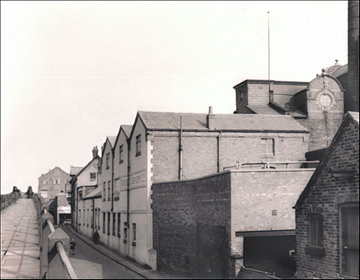 The Northgate Brewery (also here), Northgate Street, was founded in 1760 at The Golden Falcon Inn. A new brewery complex was built on the site in the 1850s and the Chester Northgate Brewery Co Ltd was registered in March 1885 as a limited liability company to acquire the business of the same name at the purchase price of £50,000. The Northgate Brewery (also here), Northgate Street, was founded in 1760 at The Golden Falcon Inn. A new brewery complex was built on the site in the 1850s and the Chester Northgate Brewery Co Ltd was registered in March 1885 as a limited liability company to acquire the business of the same name at the purchase price of £50,000.
The company acquired Salmon & Co, wine and spirit merchants, Chester in 1890 and the Kelsterton Brewery Co Ltd, Kelsterton, Clwyd with 93 licenced houses, in 1899. By 1891 the company owned 21 tied houses in Chester and numerous others within a radius of 15 miles from the city.
It was the only Chester brewery to survive beyond 1914. In its turn, it was acquired by Greenall Whitley & Co Ltd in 1949 with about 140 tied
houses. Brewing ceased in 1969 and it was demolished in 1971. An unsympathetic office
block, Centurion House, now occupies the site. Here is our gallery of photographs of the old brewery.
"The Northgate Brewery was a good company to work for... I remember being told to go up to the brewer's office with my best friend Winnie for a spoon full of yeast to get rid of our pimples... it never worked!" May Williams who worked at the brewery during the war years.
The Northgate Brewery may have closed forty years ago but Northgate Ale is back, thanks to local brewer John Murray. And very nice it is too- at 4.9 ABV it 'kicks like a horse' and is definitely this writer's tipple of choice. It is made at the Spitting Feathers Brewery in the nearby village of Waverton (hit the 'Heritage Ales' link when you visit). Go here to learn more and here to see some fascinating pictures of the old Northgate Brewery...
 The Lion Brewery,
Pepper Street, was founded in 1642. It was registered in May 1896 to
acquire the business of Thomas Montgomery with 40 public houses.
It was acquired by Bent's Brewery Co Ltd in 1902. The
building was demolished in 1969 and replaced by a multi-storey car
park. The Chester Civic Trust rescued the large stone lion- the business's trademark- which stood atop the brewery's tower, and re-erected it on top of the new car park's tower,
where it remains a prominent feature today. Some pictures of the old brewery can be seen on its own page in our lost pubs gallery.. The Lion Brewery,
Pepper Street, was founded in 1642. It was registered in May 1896 to
acquire the business of Thomas Montgomery with 40 public houses.
It was acquired by Bent's Brewery Co Ltd in 1902. The
building was demolished in 1969 and replaced by a multi-storey car
park. The Chester Civic Trust rescued the large stone lion- the business's trademark- which stood atop the brewery's tower, and re-erected it on top of the new car park's tower,
where it remains a prominent feature today. Some pictures of the old brewery can be seen on its own page in our lost pubs gallery..
 Snape and Bagnall's Brewery- is mentioned in the Cheshire Sheaf as being located "in the vicinity of King's Buildings close to the archway that leads to the canal" and existing in 1831. It was later being operated by a Mr Clubbe (members of the Clubbe family were licencees of the Grosvenor Arms, Handbridge- stiil known today as 'Clubbie's'- relations perhaps?) - and later still was known as Huxlie's Brewery. Joseph Clubbe is listed in a trade directory as a brewer in 'King's Street' in 1795 and Thomas Clubbe in the same trade and location in 1822-3. Snape and Bagnall's Brewery- is mentioned in the Cheshire Sheaf as being located "in the vicinity of King's Buildings close to the archway that leads to the canal" and existing in 1831. It was later being operated by a Mr Clubbe (members of the Clubbe family were licencees of the Grosvenor Arms, Handbridge- stiil known today as 'Clubbie's'- relations perhaps?) - and later still was known as Huxlie's Brewery. Joseph Clubbe is listed in a trade directory as a brewer in 'King's Street' in 1795 and Thomas Clubbe in the same trade and location in 1822-3.
An ancestor of the aforementioned Mr James Snape had previously owned a brewery at Barrel Well Hill in Boughton- which, during the 18th century also offered cold baths "with a reputation for health-giving properties". The premises, described as a "well-established porter, ale and beer brewery with new erected steam engine, copper coolers etc with shipping quay at the front and an excellent family house and gardens" was advertised for sale in 1809 and the site was taken over by the Chester Waterworks Company in 1826 (whose successors still own it). The brewery had presumably moved to King Street by that time.
The Abbey Brewhouse produced ale for the monks of Chester Abbey, now the Cathedral,
and also probably for sale in the town. It, together with the bakehouse
and other industrial buildings, were removed in the 18th century to
make way for for the grand houses in Abbey Square.
Edward R. Seller's Brewery was in Foregate Street. It was acquired by the Albion Brewery Co Ltd of Wigan c.1890.
Robert Cooper Drury, Francis Street (recorded as trading in 1890), John Dutton, Egerton Street (1892), Henry Knight, Park Street (1902), James Parry, Barr's Brewery, Foregate Street (1890). An ancient house in Lower Bridge Street, Paris's Hall, home of Richard the Engineer, master mason of Chester Castle and, around 1277, the builder of Flint Castle, was converted into a brewery in the early 19th century. Part of the vanished Old Coach Row and standing next to St. Olave's Church, the site is now occupied by a large, ugly and extremely inappropriately-situated car showroom.
It is said that, in former times, beer was brewed at the Liver Inn in Brook Street, (closed in 2004 but recently reopened after restoration as a hotel) the water for which was drawn directly from a culverted stream, the Flookersbrook, that flowed- and doubtless continues to flow- beneath the building and from which Brook Street derives its name.
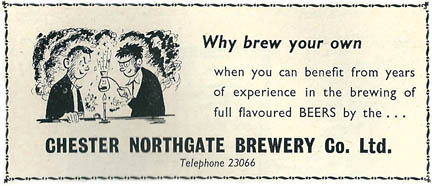 We're grateful to Chester brewer John Murray for the following: Across the River Dee, the Queens Park Brewery was situated on the north corner of the junction what is now Elizabeth Crescent and Edinburgh Way. It is shown in maps of 1835, 1845 and 1875, but had gone by 1885. The OS maps show a fresh water spring in the corner of the brewery site, so presumably this was used to supply the brewery. We're grateful to Chester brewer John Murray for the following: Across the River Dee, the Queens Park Brewery was situated on the north corner of the junction what is now Elizabeth Crescent and Edinburgh Way. It is shown in maps of 1835, 1845 and 1875, but had gone by 1885. The OS maps show a fresh water spring in the corner of the brewery site, so presumably this was used to supply the brewery.
The 1871 census of St Bridget, Chester (for some reason Queens Park was in this parish rather than St Mary’s) shows William Richards, Brewer and Maltster (born c 1838 Newtown, Montgomeryshire) living at the brewery with his wife Harriet (born Chester c 1832) and daughter Ada (born Chester c 1865) and 2 servants.
By the 1881 census, the brewery had reverted to a private dwelling named "The Woodlands" occupied by the Couroy family.
The 1861 census shows William as Malster and Livery Stable Keeper living at 9 Linenhall Street with Harriet and son John B (born Chester c 1860), stepson George J Griffith (born Chester c 1851) and stepdaughter (born Chester c 1855). William and Harriet married in Liverpool in September 1858. According to the 1851 census, Harriet was previously married to James Griffith, a cab proprietor, and lived in Walls Lane, Chester. James died in December 1856.
William Richards owned the Shakespeare Inn, an alehouse in Foregate Street (now the Asia Tandoori), presumably as an outlet for his beer. He sold this in 1882 to the Lion Brewery Company (see above). After the sale of the pub, the 1891 Welsh census shows that William and Harriet bought and ran the Wynnstay Arms in Ruthin.
No trace of the Queen's Park Brewery remains today as the area was redeveloped in the 1960s. However householders regularly unearth bottles and other items connected with the brewery in their gardens and barley and hops now grow wild in the fields and hedgerows near the former brewery.
William Beck was a brewer in Northgate Street in 1789.
 Pigot & Co's Cheshire Directory for 1828-9 lists the following brewers in Chester: Joseph Bateman, Foregate Street (also mentioned in 1840), Samuel Brasher, York Street (still at it in 1840 but in Queen Street), George Eaton, Northgate Street, Jos. Ellis, 70 Lower Bridge Street, Robert Miller, Brook Street, Newell & Gaman, Lower Bridge Street, David Parker (retail), Foregate Street, Parry & Swettenham, Foregate Street, Seller & Sage, Foregate Street, Snape & Bagnalls, King Street, Tilston Edward & Co, Dee Side Brewery, Whittle & Jones, Pepper Street. Pigot & Co's Cheshire Directory for 1828-9 lists the following brewers in Chester: Joseph Bateman, Foregate Street (also mentioned in 1840), Samuel Brasher, York Street (still at it in 1840 but in Queen Street), George Eaton, Northgate Street, Jos. Ellis, 70 Lower Bridge Street, Robert Miller, Brook Street, Newell & Gaman, Lower Bridge Street, David Parker (retail), Foregate Street, Parry & Swettenham, Foregate Street, Seller & Sage, Foregate Street, Snape & Bagnalls, King Street, Tilston Edward & Co, Dee Side Brewery, Whittle & Jones, Pepper Street.
In 1840 John Axe is listed as a brewer in Crook Street (off Watergate Street) and Charles Colton as a brewer and maltster in Northgate Street.
A Chester map of 1871 shows The Bars Brewery located between The Bars Hotel and Dee Lane in Boughton.
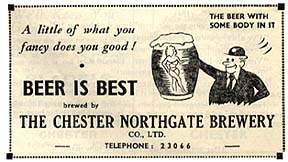 Compare the above with this list of Chester brewers from thirty years later, 1850: Brasher & Jones, York Street, Walter Booth, St. Werburgh's Place, James Broadbent, Foregate Street, John Eaton, Flooker's Brook, Peter Eaton, Northgate Street, Joseph Huxlie, King Street, Henry Knight, Park Street, Sarah Miller, Brook Street, Thomas W Pritchard, Princess Street, William John Seller and Edward Russell, Foregate Street, Robert Turner, Lower Bridge Street, Margaret White, George Street. Compare the above with this list of Chester brewers from thirty years later, 1850: Brasher & Jones, York Street, Walter Booth, St. Werburgh's Place, James Broadbent, Foregate Street, John Eaton, Flooker's Brook, Peter Eaton, Northgate Street, Joseph Huxlie, King Street, Henry Knight, Park Street, Sarah Miller, Brook Street, Thomas W Pritchard, Princess Street, William John Seller and Edward Russell, Foregate Street, Robert Turner, Lower Bridge Street, Margaret White, George Street.
"For art to exist, for any sort of aesthetic activity or perception to exist, a certain physiological precondition is indispensable: intoxication." Friedrich Nietzsche
In 1295, the army of King Edward I, while campaigning in Wales, ran short of beer. The king wrote to the Mayor of Chester to order him to summon all the brewers of the town to produce as much beer as they could and deliver it by sea at their earliest opportunity to him in Anglesey. This was doubtlessly seen as a golden opportunity by the brewers. That they succeeded in supplying the considerable needs of the great army indicates how many brewers there must have been in Chester in the 13th century.
A century later, in 1487, when Chester's authorities summoned everyone engaged in the
brewing industry to have their measures 'sealed'- officially endorsed
as being of acceptable standard, 57 brewers- the majority of them
female- and 101 ale-sellers were recorded in the town.
150 years ago, traveller and writer George Borrow was less-than-impressed
with a meal of Cheshire cheese and Chester ale served to him at the Pied
Bull in Northgate Street and a century earlier, Jonathan Swift
was equally damning about the fare at the Yacht
Inn which formerly stood in Watergate Street.
Chester ale, Chester ale! I could
ne'er get it down,
'Tis made of ground-ivy, of dirt, and of bran,
'Tis as thick as a river below a huge town!
'Tis not lap for a dog, far less drink for a man! |
In 1577, the government ordered a count be made of
all inns, taverns etc and a tax imposed on them "towards the cost of
repairing Dover Harbour". In Cheshire were found 24 inns, 9 taverns and
390 "alehouses or tippling houses"- a total of 423.
Aside from public houses actually closing down, the, as we have seen, ancient and common practice of changing their names continues apace. In the
minds of the smart young men of the brewing industry's PR departments, an often-centuries
old name doubtlessly implies a dusty, 'outdated' image- something to be avoided at all costs,
especially when they are anxious to encourage the patronage of the free-spending
'alco-pop' generation. Some examples of this are the above-mentioned Bear and Billet, which became Bensons
at the Billet, and the Red Lion in Northgate Street, to Scruffy Murphy's. However, by the end of 2001, both of these latter had reverted to their ancient names- as did the Plumber's Arms in Newgate Street, which was for a few years renamed Fagin's until being taken over by Thwaites.
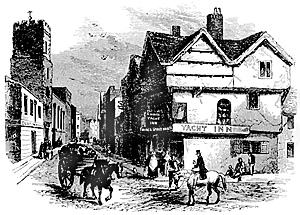 The Albion, opposite Chester
railway station, built in 1860 and renamed a few years ago as The Town Crier (actually, its original name, when it was built as the 'budget' annexe to the Queen's Hotel across the road, was The Queen Commercial Hotel.
The two establishments were connected by a service tunnel running under City Road. Those of limited means could impress their clients by meeting with them in the grander hotel and then return unseen to their accomodation in the humbler.) The Albion, opposite Chester
railway station, built in 1860 and renamed a few years ago as The Town Crier (actually, its original name, when it was built as the 'budget' annexe to the Queen's Hotel across the road, was The Queen Commercial Hotel.
The two establishments were connected by a service tunnel running under City Road. Those of limited means could impress their clients by meeting with them in the grander hotel and then return unseen to their accomodation in the humbler.)
The Watergate Inn, close to Chester Racecourse, once bore the apt name of The Turf Tavern. In 1855, when Mary A Cotton was in charge, it was The Watergate Tavern.
The Saddle Inn in
Grosvenor Street, which traded under that name for more than a century before
changing to The Chester Bells in 1996.
The Coach & Horses in Town Hall Square which, after 300 years, closed in July 2006 and, after an extensive restoration, reopened in Summer 2007, much improved, as The Coach House.
Across the river, the White Horse re-opened in April 2008 bearing the unimaginative new name, Handbridge. Similarly, here in Hoole, the Ermine Hotel has taken the name of the district in which it stands, The Flookersbrook. See our feature on the changing face of the old Ermine here.
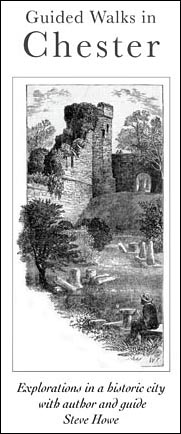 In November 2008, we heard that the old Greyhound Inn in Saughall was to change its name to The Horned Woman, in honour of an unfortunately deformed villager of the 17th century, but this proved to apply only to their restaurant. In November 2008, we heard that the old Greyhound Inn in Saughall was to change its name to The Horned Woman, in honour of an unfortunately deformed villager of the 17th century, but this proved to apply only to their restaurant.
Renaming pubs is by no means a modern phenomena, however. The curiously-misspelled Marlbororough Arms in St. John Street, for example, used to be known as The Duke of Marlborough back in 1829. The 200 year-old Axe Tavern, on the corner of Watergate and Nicolas Streets, had changed it's name from The Old Axe Tavern in 1828 to simply The Axe in 1850 (it was still called that in 1880 when Edward Greenwood was the gaffer) to The Axe Tavern in 1914. In the 1990s, it was for a while known
as The Falchion & Firkin but is now re-named Bar Lounge. It appeared on a list of polling stations in 1809.
The record for name changes must assuredly be held by the establishment on the canal, next door to Cow Lane Bridge- variously known over the years as Evergreen's, The Lock, Stock & Barrel, The Fortress & Firkin, The Frog & Nightingale, and, since October 2011, The Lock Keeper (even though there's not a lock in sight)... Many, many more examples of these often-bewilderingly frequent name changes will be met with in the 'vanished pubs' pages.
Let us finish by telling you about possibly the strangest of all the 'lost pubs of Chester'- for it remains in business to this day, albeit thirty miles away, standing in the centre of Manchester! A plaque outside the building, located at 16 Fountain Street, tells that The Shambles Public House started life somewhere in Chester in 1656 but was dismantled and transported to Manchester where it was re-erected in 1928 and renamed The Shakespeare. It replaced an original inn that had stood on the same spot since 1771. You can see a picture of this remarkable old pub and its plaque on the ChesterTourist.com website (scroll down the page a bit)..
All is not bad news, however, and traditional British boozers- small,
comfortable and affordable 'homes-from-home' where we can drink good beer, dress
how we like and converse without having to bellow over someone else's bad taste
in music- do still exist, even in Chester, albeit in increasingly small numbers. Use them or lose them!

 The Cheshire branch of CAMRA- the Campaign for Real Ale- now has its own website- go here for news and reviews of pubs and beer throughout the county. Jon
Wainwright wrote to tell us of the Chester & South Clwyd branch of
CAMRA's new website which, he tells us, "is more specific to Chester
than the Cheshire CAMRA site currently accessible from your pages"...
and very interesting and informative it is too. Thanks John. Visit them here. The Cheshire branch of CAMRA- the Campaign for Real Ale- now has its own website- go here for news and reviews of pubs and beer throughout the county. Jon
Wainwright wrote to tell us of the Chester & South Clwyd branch of
CAMRA's new website which, he tells us, "is more specific to Chester
than the Cheshire CAMRA site currently accessible from your pages"...
and very interesting and informative it is too. Thanks John. Visit them here.
• The Chester Beer Project. Brilliant, savage reviews of Chester's pubs. Hilarious and often spot-on, but undoubtedly not to everyone's taste; certainly not for the po-faced or the owners/licencees of many places mentioned, more than a few of which are doublessly soon destined to join the ranks of the 'lost pubs of Chester'... You can add your comments here too.
• For those interested in finding out about the many Chester pubs that are still with us, check out ChesterTourist.Com's pub guide. In common with the rest of the site, the layout is wonderfully eccentric but it's nontheless an interesting read and is updated regularly...
• The BBC has an interesting local history page about the old pubs of neighbouring Flintshire here.
• Here's an excellent read, penned by Thomas Hughes in 1857: On the Inns and Taverns of Chester, Past and Present.
 A happy little fact before we leave you: In 1910 to 1914, the landlady of the still-thriving Nag's Head in Bridge Trafford near Chester went by the splendidly apt name of Mrs Cheers. And cheers to all of you- an' ain't you got no 'omes to go to? A happy little fact before we leave you: In 1910 to 1914, the landlady of the still-thriving Nag's Head in Bridge Trafford near Chester went by the splendidly apt name of Mrs Cheers. And cheers to all of you- an' ain't you got no 'omes to go to?
"Will Jones, of the Feathers, will welcome his friends
And worthy Equestrians, second in grade;
At One he will lunch them, and make full amends
By the plentiful tables invitingly laid.
Mine hosts of the Hop-Pole, and Blossoms, so kind,
With the Lions, the Golden, the White, and the Red,
Smooth treatment will shew, and each customer find
Good victuals, good drink, and an excellent bed.
All our pot-houses too, and their braw Bonifaces,
Will welcome with pleasure the plain country folk;
Where a tap they will find, just prepar'd for the Races,
And may mix in the dance, and the song, and the joke".
From An Invitation to Chester Races, 1829
| "Oh, genial and gladdening is the power of good ale, the
true and proper drink of Englishmen! He is not deserving of the name of
Englishman who speaketh against ale, that is good ale... and yet there
are beings, calling themselves Englishmen, who say that it is a sin to
drink a cup of ale... and exclaim, ‘The man is evidently a bad
man, for behold, by his own confession, he is not only fond of ale
himself, but is in the habit of tempting other people with it.’
Alas! alas! what a number of silly individuals there are in this world". George Borrow: Lavengro 1851 |
|
 Wellington Street: (off George Street) In 1840, there was a pub here with the curious name of The Sign of the Board.
Wellington Street: (off George Street) In 1840, there was a pub here with the curious name of The Sign of the Board. 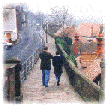


 The Northgate Brewery
The Northgate Brewery The Lion Brewery
The Lion Brewery
 We're grateful to Chester brewer John Murray for the following: Across the River Dee, the Queens Park Brewery was situated on the north corner of the junction what is now Elizabeth Crescent and Edinburgh Way. It is shown in maps of 1835, 1845 and 1875, but had gone by 1885. The OS maps show a fresh water spring in the corner of the brewery site, so presumably this was used to supply the brewery.
We're grateful to Chester brewer John Murray for the following: Across the River Dee, the Queens Park Brewery was situated on the north corner of the junction what is now Elizabeth Crescent and Edinburgh Way. It is shown in maps of 1835, 1845 and 1875, but had gone by 1885. The OS maps show a fresh water spring in the corner of the brewery site, so presumably this was used to supply the brewery. Pigot & Co's Cheshire Directory for 1828-9 lists the following brewers in Chester: Joseph Bateman, Foregate Street (also mentioned in 1840), Samuel Brasher, York Street (still at it in 1840 but in Queen Street), George Eaton, Northgate Street, Jos. Ellis, 70 Lower Bridge Street, Robert Miller, Brook Street, Newell & Gaman, Lower Bridge Street, David Parker (retail), Foregate Street, Parry & Swettenham, Foregate Street, Seller & Sage, Foregate Street, Snape & Bagnalls, King Street, Tilston Edward & Co, Dee Side Brewery, Whittle & Jones, Pepper Street.
Pigot & Co's Cheshire Directory for 1828-9 lists the following brewers in Chester: Joseph Bateman, Foregate Street (also mentioned in 1840), Samuel Brasher, York Street (still at it in 1840 but in Queen Street), George Eaton, Northgate Street, Jos. Ellis, 70 Lower Bridge Street, Robert Miller, Brook Street, Newell & Gaman, Lower Bridge Street, David Parker (retail), Foregate Street, Parry & Swettenham, Foregate Street, Seller & Sage, Foregate Street, Snape & Bagnalls, King Street, Tilston Edward & Co, Dee Side Brewery, Whittle & Jones, Pepper Street. Compare the above with this list of Chester brewers from thirty years later, 1850: Brasher & Jones, York Street, Walter Booth, St. Werburgh's Place, James Broadbent, Foregate Street, John Eaton, Flooker's Brook, Peter Eaton, Northgate Street, Joseph Huxlie, King Street, Henry Knight, Park Street, Sarah Miller, Brook Street, Thomas W Pritchard, Princess Street, William John Seller and Edward Russell, Foregate Street, Robert Turner, Lower Bridge Street, Margaret White, George Street.
Compare the above with this list of Chester brewers from thirty years later, 1850: Brasher & Jones, York Street, Walter Booth, St. Werburgh's Place, James Broadbent, Foregate Street, John Eaton, Flooker's Brook, Peter Eaton, Northgate Street, Joseph Huxlie, King Street, Henry Knight, Park Street, Sarah Miller, Brook Street, Thomas W Pritchard, Princess Street, William John Seller and Edward Russell, Foregate Street, Robert Turner, Lower Bridge Street, Margaret White, George Street.  The Albion, opposite Chester
railway station, built in 1860 and renamed a few years ago as The Town Crier (actually, its original name, when it was built as the 'budget' annexe to the Queen's Hotel across the road, was The Queen Commercial Hotel.
The two establishments were connected by a service tunnel running under City Road. Those of limited means could impress their clients by meeting with them in the grander hotel and then return unseen to their accomodation in the humbler.)
The Albion, opposite Chester
railway station, built in 1860 and renamed a few years ago as The Town Crier (actually, its original name, when it was built as the 'budget' annexe to the Queen's Hotel across the road, was The Queen Commercial Hotel.
The two establishments were connected by a service tunnel running under City Road. Those of limited means could impress their clients by meeting with them in the grander hotel and then return unseen to their accomodation in the humbler.) 
 A happy little fact before we leave you: In 1910 to 1914, the landlady of the still-thriving Nag's Head in Bridge Trafford near Chester went by the splendidly apt name of Mrs Cheers. And cheers to all of you- an' ain't you got no 'omes to go to?
A happy little fact before we leave you: In 1910 to 1914, the landlady of the still-thriving Nag's Head in Bridge Trafford near Chester went by the splendidly apt name of Mrs Cheers. And cheers to all of you- an' ain't you got no 'omes to go to?

